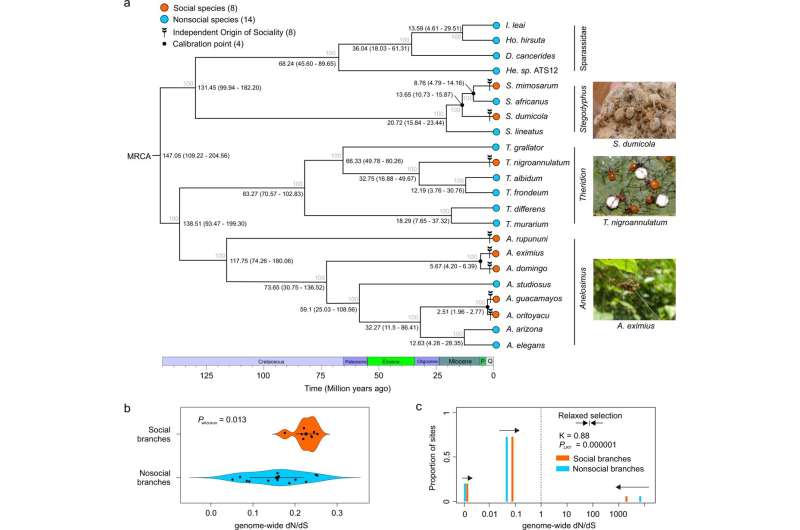
A team of researchers at the University of Pennsylvania, Texas Tech University, Cornell University and Australian National University has found similar genes between species of spiders that have some degree of sociability. They have published their paper in the journal Nature Communications.
Spiders are well known for living an antisocial, solo existence—most build webs alone, live on them and only interact with others of their kind when it comes time to mate. But prior research has shown that some species do exhibit some degree of sociability.
In one species, mothers were found to protect their offspring from predators, for example. Such examples are known as sub-social behaviors. Other species, such as the Australian huntsman, have been found to share meals. Such types of social behavior are better described as tolerance, the researchers note, than as demonstrations of sociability. Still, they suggest such behaviors may be indications that spiders are evolving to become more social. Doing so has made most other species more resourceful and therefore more successful.
Prior research has also shown that along with sociability comes a bigger brain. Creatures that socialize have to do all the things that nonsocial species do while getting along with others of their kind. This presents a problem for spiders, because they do not have centralized brains. Instead, they have clusters of nerves distributed throughout their bodies.
Still, prior research has shown that spiders that exhibit some degree of sociability do have more developed nervous systems than spiders that do not. In this new effort, the researchers looked for differences between social and nonsocial spiders. Their work involved comparing the genomes of 22 spider species with some degree of sociability.
They found evidence of genetic changes compared to other spiders, which allowed the spiders to be more social. This development could prove challenging for prey, the researchers note, if such social activities involve spiders teaming up to improve their hunting skills.
More information: Chao Tong et al, Genomic signatures of recent convergent transitions to social life in spiders, Nature Communications (2022). DOI: 10.1038/s41467-022-34446-8
© 2022 Science X Network
Citation: Sociability genes found in some spiders (2022, November 28) retrieved 28 November 2022 from https://ift.tt/m23JN80
This document is subject to copyright. Apart from any fair dealing for the purpose of private study or research, no part may be reproduced without the written permission. The content is provided for information purposes only.
"some" - Google News
November 28, 2022 at 10:20PM
https://ift.tt/Bc8wRK5
Sociability genes found in some spiders - Phys.org
"some" - Google News
https://ift.tt/wT9R4CY
Shoes Man Tutorial
Pos News Update
Meme Update
Korean Entertainment News
Japan News Update
Bagikan Berita Ini














0 Response to "Sociability genes found in some spiders - Phys.org"
Post a Comment